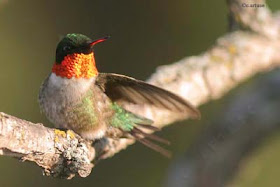“Shearwater” is a beautiful word - describing the way these birds speed low across the sea surface as if cutting (shearing) the water with their long and slender (knife-like) wings. To me it also is like a play on the word "sheer" (versus “shear”) because these birds can be seen out in the sheer immensity of the ocean, earning a living in what seems like the harshest of environments to a land bound primate.
The flight style of shearwaters and other seabirds – tilting their body to slice the ocean breeze and serpenting across the surface, rising above the waves while seldom flapping – is a product of their incredibly long and narrow wings. When comparing wing shapes, ornithologists talk about “aspect ratio”, i.e. the ratio between a wing’s length and its depth. For example, large hawks and eagles that soar on thermal currents have broad rounded wings that maximize the wing area and hence increase their ability to ride on thermals. Shearwaters live on the windy ocean and out there their long narrow wings reduce drag, in part because the wing tip is so small in comparison to the length of the leading edge of the wing. It is the aerodynamic properties of this wing shape that make it so common for pelagic species and this is what has made the large albatrosses have the longest wingspans of any living bird (but remember their wings are narrow not broad like a condor for example). Shearwaters can also reduce drag by sticking close to the water surface, especially in calmer winds. In windier conditions, they can also use the updrafts created by waves for lift. In the first two photos of this post, an
Audubon’s Shearwater demonstrates their flight style…


And here the larger
Cory’s Shearwater also demonstrates, tilting back and forth and gliding low across the water on a calm day…

Of course, even these amazing flyers need a rest from time to time and they are quite happy to sit on the surface. Here are two
Cory’s Shearwaters.
Here is a comparison of Cory’s Shearwater (right) and Greater Shearwater (left). You would think that, given their name, the "Greater" Shearwater should be larger but that is clearly not the case.
And here is a mixed flock of Cory’s Shearwaters and Greater Shearwaters. You may wonder why so many birds would congregate in one place. The shortest answer is because thy go where there is good feeding.

To understand why some areas are so rich in seabirds whereas in other areas you can go for miles without seeing even one, you need to understand the food web in the ocean. For seabirds, as with landbirds, everything comes back to primary productivity. Sunlight can only penetrate a certain depth and oxygen can be quickly depleted unless there are currents to stir things up. This is why ocean currents are so vital – they cycle nutrients towards the surface and allow the food web to regenerate itself without exhausting the available resources. Where the water is still, such as in many tropical areas (unless there is a current moving in from colder areas), seabirds are few and far between due to limited feeding opportunities near the surface. The vast majority of the world’s true pelagic species occur in the vast, cold southern oceans and, to a lesser extent, in the cold northern waters (there is more land and less water in the Northern than the Southern Hemisphere).
The above photo of a large flock of shearwaters was taken on the edge of a very large underwater canyon called Baltimore Canyon. In this case, it is the topography of the canyon that forces cold water upward towards the surface and the nutrients that these where upwellings bring create many feeding options for many forms of wildlife… and wildlife that east other wildlife and… you get the picture! That is why we made the long journey (4 hours of straight sailing) to get out to this area.
Of course, it is one thing to use your long wings to slice the wind when aloft but getting airborne in the first place is a greater challenge. An albatross’s or shearwater’s wings are so narrow that they don’t generate much lift in flapping flight. On nesting cliffs, it is easy to dive off the cliff to build up speed and then swoop upward; however, on level land or level water, large seabirds have to run or “paddle” to generate lift. Their long, wobbly, running take off can be rather comical at times. Allow this Greater Shearwater to demonstrate how it is done…
























































